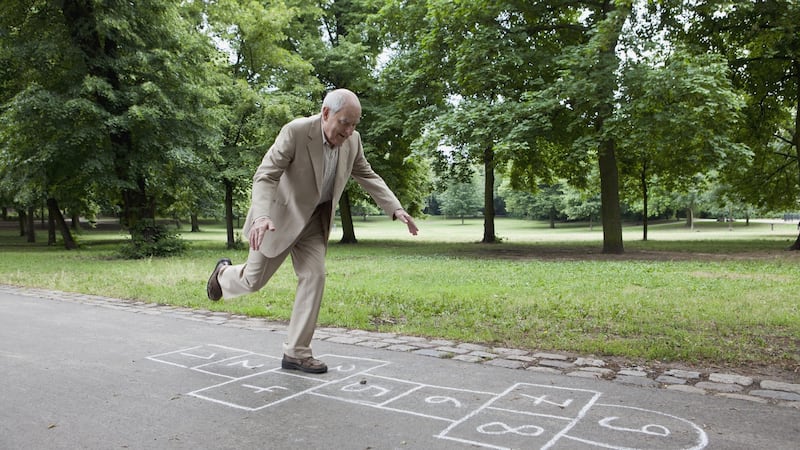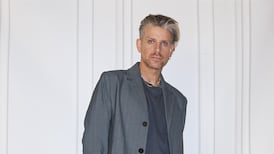Half of the babies born today in industrialised countries will live long enough to celebrate their 100th birthday.
According to a study by the Danish Aging Research Center at the University of Southern Denmark published in The Lancet in 2009, we're not only living longer, we're living better, with less disability and fewer limitations – although, as Prof Rose Anne Kenny of the Mercer Institute for Successful Ageing points out, we can't afford to take this for granted. Demands on the health system will mean we will be forced to take more control of our own health management in the future.
In Ireland average life expectancy has increased from 70 for a baby born in 1960, to 82 for a child born 55 years later, data compiled by the World Bank shows.
So what will life be like for babies born in 2017 if they live to be 100? How will society, our homes, our cities, the way we work, live – and even love – evolve over the next century?
The Irish Times asked big thinkers in a range of fields – futurologists, economists, urban planners, psychologists, as well as experts in medicine, technology and finance – for their predictions.
Some things are so fundamental to human behaviour, it’s hard to imagine they will change. To paraphrase Nassim Taleb, if you were able to get in a spaceship and travel back in time to Pompeii for dinner, you’d find yourself sitting around a table, being served by a waiter, drinking wine and enjoying good food and company. With that in mind, we also asked our panel of experts for their views on what is likely to stay the same.
Here are their predictions.
Life at home
In 50 years’ time, a baby born in 2017 will live in a home in which “energy, entertainment, food consumption and security needs” will all be interconnected, says Dr Rob Mooney, research director at Amárach research specialists.
“Their fridge will automatically put in their shopping order, and it will be delivered by driverless cars.”
A home in 2067 “could have all its roof tiles made from solar tiles. There will be energy storage devices in the walls of the house and electric car ports.

“Houses will be built with energy capture in mind – we are already commercialising window panes that will capture energy,” Mooney adds.
Homes of the future will be truly smart, in the sense that they will learn from their owners, predicts behavioural futurist William Bingham of the London-based consultancy, Next Big Thing. “We’ll be less likely to want to own our own homes – we’ll move towards the European model of renting homes.”
He suggests these homes will be instantaneously adaptable, with walls that can change colour at the flick of a switch, and the ability to 3D-print furniture. “Our homes will become like student dorms – each one will be the same empty shell, but you can direct and adapt them as you like. Our housing complexes will become these amazing shared communities with offices, gyms, gathering spaces.”
Samsung SmartThings’s Future Living report envisions homes with walls and floors made of a malleable “skin”, and embedded with tiny sensors and so that rooms can be subdivided and adapted, and that “cooking dinner” for the 2017 baby could mean 3D printing a gourmet meal.
In other food trends, synthetic proteins will play a part as natural sources become more scarce, says Rob Mooney. “The driving force of this will be sustainability. In fact, sustainability will be the underlying factor in everything from travel, food, the economy to housing.”
By 2067 robots will help with household tasks, and even take care of children, predicts Klaus Mogensen, senior futurist with the Copenhagen Institute for Futures Studies in Denmark.
“We will have intelligent, emotionally engaged digital robotic servants who will increase our independence and accelerate the trend towards more and more people living on their own. It will be a challenge for human communities,” says cognitive neuroscientist and professor of psychology at Trinity, Ian Robertson.
Human relationships
The psychologist and author Maureen Gaffney, who is working on a book that examines our emotional needs at different phases in our lives, is wary of making predictions. “We have a long and inglorious history trying to predict what’s going to happen in 10 years, not to mind 50 or even 100.”
But she believes the things that make us human – our basic needs for closeness, autonomy and competence – “are not going to change. There will be more options about how we express those needs but their intensity, their universality won’t change”.
The trend towards increasing longevity will heighten the strain on our personal relationships, as we live longer, and the boundaries of young adulthood and middle-age stretch and blur. “We don’t even enter adulthood until we’re in our very late 20s now, and we don’t exit young adulthood until we’re well into our 40s. People are reinventing themselves throughout their lives, and expecting their partner to keep up.”

Couples are also spending less time together. “So the unstoppable force is that we expect more and more of our relationships, but the immovable object is that we’re spending less time together. I’d put money on that dynamic intensifying into the future.”
As a result, Gaffney expects couples of the future will have to take a more strategic approach to the wellbeing of their relationships, “approaching relationship competencies akin to job competencies”.
The other trend she expects is a continued upswing in “silver divorces”. “These are couples who, when the kids are well gone, find themselves in their 60s looking at another 25 years together and deciding it’s not what they want.”
Our 2017 baby might expect to enjoy different relationships at different phases in his or her life but that doesn’t mean we’ll be able to out-engineer sadness. A break-up is always going to be painful, says Gaffney. “There will be better services for people before they get married, more ways to correct course when they run into trouble but if and when they break up, it doesn’t mean all the pain will go away.”
Life in cities
"The first thing that we are pretty certain about is that by 2050 the population of Dublin will reach 2.6 million people. Nationally, we're talking about an increase to more than six million. I think we will see skyscrapers emerging across the Dublin skyline sooner than you might think," says Mooney, who is also the author of Dublin Chamber's A Vision for Dublin 2050 report.
He adds that, over the next 50 years, the east coast is going to continue to have “a disproportionate population density – even more so than today if trends continue in the same direction. So the big priority over the next 10 years is planning effectively to address the current housing crisis”.
Dr Frank Crowley, lecturer in economics at Cork University Business School, says “there are no indicators presently that the movement from rural to urban areas will switch the other way. Firms and individuals will continue to converge to core city areas”.
'In the future, it will be less about urban vs rural, and more about attitude'
One of the advantages of the move “upwards” will be the “capacity to develop key social amenities and social spaces” making Dublin “a city to grow up, raise a family and grow old in”.
“We’ll have more skyscrapers, and much more integration with the natural environment. You’ll see buildings with planting all the way up, topped with roof gardens which will be essential to act as carbon sinks,” says Mooney.
Futurist William Bingham says communities of like-minded people will emerge within cities: “the geographical equivalent of Facebook filter bubbles. In the future, it will be less about urban vs rural, and it’s more about attitude. People will decide, for better or worse, that they want to live with like-minded people”.
Education and work
A baby born today will still seek a degree, but they’ll also supplement their education as we move towards “a ‘lifelong learning’ space, with people dipping in and out of education” throughout their lives, says Mooney. “We already have MOOC’s [Massive Open Online Courses] providing free access to basic level education on a global scale.”
With the increasing automation of routine work, more creative skills will become valuable says Klaus Mogensen. “The jobs that are more important in the future will be creative competencies combined with more technical knowledge. A lot of the education we get today is ‘just in case’ education. In the future it might be ‘just in time’ education because you need new competencies.”
One of Mogensen’s more surprising predictions for the children of 2017 is that they “will not have to learn how to write. We have speech detection software which is getting very good, and we will have better speech-to-text software, making writing and even typing unnecessary”. In 100 years “we may not have to be able to read”, as we’ll have software to do it for us instead.

The skills required to navigate personal relationships could become part of the general education curriculum, says Maureen Gaffney. “There have been initiatives around wellness and mindfulness, but I think the revolution that has to come is going to go beyond wellness.”
Our experts are almost unanimous in the view that children born in 2017 will work longer than their parents.
Prof Rose Anne Kenny, who is professor of medical gerontology at Trinity College Dublin as well as director of the Mercer Institute for Successful Ageing, says “with the implicit changes in the dependence ratio – the proportion of people who are not working to those who are working – we will be required to work longer. It’s not sustainable to retire at 65 and live to 100”.
It is a simple question of numbers, says Mogensen. “Roughly, now people contribute from age 20 to the age of 60 or 65, so one third of our lives are unproductive. We need to make three quarters of our lives active.”
Children born today will take a less linear approach to career, suggests Doone O’Doherty, People and Organisation partner at PWC. “If they are going to work until 75, they will want to be constantly challenged. They will want to learn, they may want to take a career break, they may change career halfway through their working lives.”
Employers will have to offer greater flexibility to keep employees engaged, including “three-day weekends, more holiday entitlements, mentoring programmes – the older generation mentoring the younger generation but also reverse-mentoring,” says O’Doherty.
Mogensen expects to see a trend of people turning hobbies into a main or supplemental income stream. “It might not be an ‘either/or’ – people might work fewer hours in the original career, and more hours in the new business.”
Technology and communications
Tomorrow’s workforce will spend a lot less time commuting. “Telecommunications, including remote holograph attendance at meetings, will mean that physical commuting will become redundant, as will an awful lot of work,”predicts Prof Ian Robertson of Trinity College.
Virtual reality (VR) and augmented reality (AR) will play a major role in the workplaces of the future. “Virtual boardrooms, virtual travel, surgeons conducting virtual operations with the help of robotics” will be commonplace, says Mooney.
“A lot of jobs are going to be done by robots in the next 50 or so years; yet as with the industrial revolution, different jobs will emerge to take their place.”

As the virtual world becomes more compelling, there is a risk, says Robertson, that people might choose to make “a flight from polluted realities into a world of virtual work, virtual relationships, maybe even virtual sex”.
Infrastructure and energy
“There is no reason why Ireland couldn’t be the global leader in the field of renewable technologies,” says Mooney.
“We are in a unique position on the Atlantic coast for the production of wind and wave power. We need to focus on developing these renewables, and also harness the excellent research already happening in Ireland in this area to drive those innovations forward.”
With the move to smart grid technologies, our 2017 baby may not be an energy consumer but a “prosumer”, providing energy back to the grid, he suggests.
In travel, major changes are coming, including “hyperloops – sealed tube or system of tubes through which a pod travels free of air resistance or friction” at speeds of up to 970km per hour.
At local level, a baby born today will be able to travel from Dublin to Cork in a matter of minutes in 50 years. “If you’re going further afield, there will be standardised space flights,” predicts Mooney. “Theoretically, you could live in Dublin and work anywhere in the world.”
The emergence of driverless electronic vehicles over the next 10 years and beyond has enormous implications
The baby of 2017 may never own their own car, says William Bingham. “In the same way that some people own a horse in 50 years as a hobby, the odd person might own a car to tinker with it.”
The emergence of driverless electronic vehicles over the next 10 years and beyond has enormous implications for the future transportation system, says Mooney.
He predicts tomorrow’s commuters will avail of “a service facility where you pay a company who have a fleet of driverless cars readily available” no more than 90 seconds from any location. “They will pick you up at the same time and day for standard trips, and are flexible for other trips.”
This would have the potential “to radically reduce road deaths and injury, speed up commuting times, remove traffic congestion, link directly with public transport systems, increase working capacity with luxury models fitted with working office environments, reduce stress, and reopen up pub culture in rural Ireland.”
It has been a mistake to have planned our cities around the car, says Dr Frank Crowley. “Cycling and walking will be as important as any mode of transport. As humans, we have an inherent need to move, so these forms of transport should always be at the core of everything we plan for. Further, if – for example – flying cars are the future, then investment in roads and the separation of commercial, industrial and residential spaces will have proved nonsensical.”
Medicine and health
Few people have given more thought to what increasing longevity means for us as individuals and as a society than Kenny. “The biggest issue is not just extending our lifespan, but ensuring a healthy lifespan. There’s no point in living to 100 if you spend the last 30 years in a nursing home, blind and demented. The most efficient way of doing that is for people to be responsible for their own health management,” she says.
Kenny predicts that a baby born in 2017 will rely on a medical implant to provide them with feedback on “their entire physiology, including heart rate, cardiac output, microbiome status, metabolism and physical activity. It will all feed into a single data pool which will then recommend an activity or a medical intervention”.
Precision medicine, “or personalised medicine, will become the norm for people who can afford it,” agrees Robertson.
He is optimistic we will eventually be able to prevent some types of Alzheimer’s, along with many types of cancer and heart disease. “In terms of disorders of the mind,I believe that a combination of psychology, technology and nutrition will replace much of the pharmaceuticals that are so widely used today.”
Cancer is no longer a death sentence, says Kenny. She is less certain that a cure for Alzheimer’s is imminent, given that up to €40 billion in research has already been spent, but adds that the management of blood pressure, diabetes, physical activity and obesity is known to “reduce the likelihood of Alzheimer’s by up to 40 per cent”.
Mogensen points out that “each generation lives five years longer than the previous generation. It’s possible we’ll get a breakthrough that will allow people to live indefinitely. It will be too costly for everybody so in reality, only the economic elite will be able to live indefinitely”.
Money and banking
How we think about money and banking will change dramatically over the lifetime of a baby born today, suggests tech expert and serial start-up founder, Richard Rodger. By the time our 2017 baby is 50, physical money will have come to be seen as “very quaint, a collector’s item, almost like vinyl [records]”.
“I think we’re going to see a new breed of fintech start-ups that will find new ways to use blockchain technology we haven’t even thought of yet to completely disrupt the banking sector.”
He points out that there are a lot of “quacks and scam artists” operating in this space, but “when we figure out what it’s useful for, there will be a lot of disruption. China and WeChat show the way – everything will be electronic, it will go through mobile devices”.
The dark side is that every transaction could conceivably be recorded. “There are huge implications for personal freedom.”
In 100 years, he suggests, “money won’t exist. If we solve the energy problem, there won’t be a need for money. Technology removes scarcity.”
If we can produce anything using 3D printing – or whatever the next generation is – “it could alleviate the need for money all together and we could all end up living on some form of universal basic income. The question then is: does that mean a resurgence of communism?”
A universal basic income is already being mooted as a solution to the income gap that may continue to widen as automation and robotics take hold, suggests O’Doherty. “Certain sectors will survive or thrive in an automated world – those in healthcare, in professional services for example, but others won’t be so lucky. How do we address the income gap? Bill Gates suggested a tax on robots. The universal basic income is the other option. It’s being trialled at the moment in Finland and in the Netherlands. The rub is that it’s either set so low, it doesn’t help citizens, or it’s so high, it discourages people from working.”

The extent of income inequality in the future depends on “whether our – hopefully – AI-augmented governments ensure policies to re-distribute the wealth accumulated by the few masters and mistresses of technology, who will together accumulate trillions in wealth,” says Ian Roberston.
He believes some form of universal wage is inevitable and that “we will have to foster a different type of education focused on creativity and personal development”.
Life beyond earth
There could be a functioning space economy within the next 20 years, following the path of the railroads in 19th century, predicts Richard Rodger, with a “robber baron-type space era dawning over the next 20-50 years. Space is not a technological problem; it’s a cost problem. Once the cost problem is solved, it will be much more about the economics and the business model. People will see opportunities like they did in the railroad era, and there will be a proliferation of space start-ups beyond what Elon Musk is pioneering.”
One hundred years from now, “does Mars declare independence from earth? Will there be terraforming?” he wonders.
Mooney points out that space is one area where we have so far, as a species, under-performed. “If you take science fiction, the base line for many scientific predictions, everybody thought we’d have flying cars, hover boards, and live on the moon or Mars by now – there are fundamental laws of physics that present challenges to achieve this; mainly the limitations of the human body. I think people will have landed on Mars and come back, but I don’t see colonization happening in the next 50 years. In 100 years – who knows?”
What won’t change?
On the question of what won’t change, our experts are almost unanimous: the desire for human engagement and interaction is top of the list. “The need for community, the need for engagement will continue to be the fundamental driver of human activity,” says Mooney.
“Identity, culture, connections, the need to meet, to be active will always be at the core of everything we do – so place, locations and community will always be important. There will always be a place we call home – but the world will be overwhelmingly urban as we need to interact for ideas and for experiences,” says Crowley.
Bingham’s prediction is that communities will become more important as super-powers fragment. “We might see a return to city states, and the resurgence of small communities, as people decentralise their lives more.”
The enjoyment of food will still be part of the human experience, says Mogensen. “A lot of previous generations of futurists have been surprised that we’re still cooking our own dinner but food is about more than sustenance, it’s a sensual, shared experience.”
Gaffney says we need to be vigilant about making sure that need for interaction continues to be met in the future.
“Breaking bread together is a very primitive way to have a routine of closeness, and that’s one of the things that is under assault by technology. I’m cautiously optimistic about the future: my stance always is there is so much capability in human beings that we’ve only barely tapped into. But you have to be constantly vigilant about the forces that are assaulting it.”












